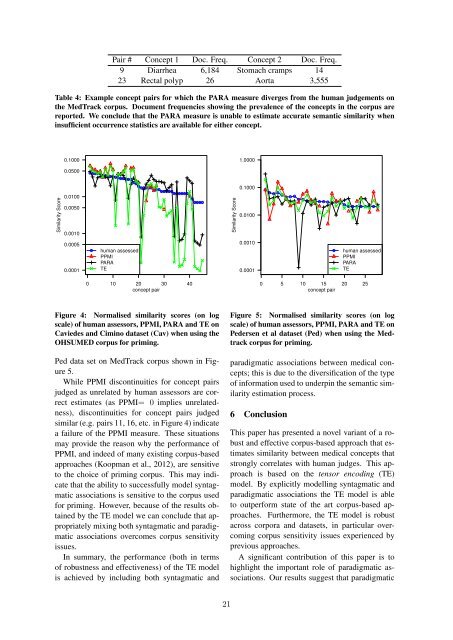Full proceedings volume - Australasian Language Technology ...
Full proceedings volume - Australasian Language Technology ...
Full proceedings volume - Australasian Language Technology ...
You also want an ePaper? Increase the reach of your titles
YUMPU automatically turns print PDFs into web optimized ePapers that Google loves.
Pair # Concept 1 Doc. Freq. Concept 2 Doc. Freq.<br />
9 Diarrhea 6,184 Stomach cramps 14<br />
23 Rectal polyp 26 Aorta 3,555<br />
Table 4: Example concept pairs for which the PARA measure diverges from the human judgements on<br />
the MedTrack corpus. Document frequencies showing the prevalence of the concepts in the corpus are<br />
reported. We conclude that the PARA measure is unable to estimate accurate semantic similarity when<br />
insufficient occurrence statistics are available for either concept.<br />
0.1000<br />
1.0000<br />
0.0500<br />
0.1000<br />
Similarity Score<br />
0.0100<br />
0.0050<br />
0.0010<br />
Similarity Score<br />
0.0100<br />
0.0005<br />
0.0001<br />
human assessed<br />
PPMI<br />
PARA<br />
TE<br />
0.0010<br />
0.0001<br />
human assessed<br />
PPMI<br />
PARA<br />
TE<br />
0 10 20 30 40<br />
concept pair<br />
0 5 10 15 20 25<br />
concept pair<br />
Figure 4: Normalised similarity scores (on log<br />
scale) of human assessors, PPMI, PARA and TE on<br />
Caviedes and Cimino dataset (Cav) when using the<br />
OHSUMED corpus for priming.<br />
Ped data set on MedTrack corpus shown in Figure<br />
5.<br />
While PPMI discontinuities for concept pairs<br />
judged as unrelated by human assessors are correct<br />
estimates (as PPMI= 0 implies unrelatedness),<br />
discontinuities for concept pairs judged<br />
similar (e.g. pairs 11, 16, etc. in Figure 4) indicate<br />
a failure of the PPMI measure. These situations<br />
may provide the reason why the performance of<br />
PPMI, and indeed of many existing corpus-based<br />
approaches (Koopman et al., 2012), are sensitive<br />
to the choice of priming corpus. This may indicate<br />
that the ability to successfully model syntagmatic<br />
associations is sensitive to the corpus used<br />
for priming. However, because of the results obtained<br />
by the TE model we can conclude that appropriately<br />
mixing both syntagmatic and paradigmatic<br />
associations overcomes corpus sensitivity<br />
issues.<br />
In summary, the performance (both in terms<br />
of robustness and effectiveness) of the TE model<br />
is achieved by including both syntagmatic and<br />
Figure 5: Normalised similarity scores (on log<br />
scale) of human assessors, PPMI, PARA and TE on<br />
Pedersen et al dataset (Ped) when using the Medtrack<br />
corpus for priming.<br />
paradigmatic associations between medical concepts;<br />
this is due to the diversification of the type<br />
of information used to underpin the semantic similarity<br />
estimation process.<br />
6 Conclusion<br />
This paper has presented a novel variant of a robust<br />
and effective corpus-based approach that estimates<br />
similarity between medical concepts that<br />
strongly correlates with human judges. This approach<br />
is based on the tensor encoding (TE)<br />
model. By explicitly modelling syntagmatic and<br />
paradigmatic associations the TE model is able<br />
to outperform state of the art corpus-based approaches.<br />
Furthermore, the TE model is robust<br />
across corpora and datasets, in particular overcoming<br />
corpus sensitivity issues experienced by<br />
previous approaches.<br />
A significant contribution of this paper is to<br />
highlight the important role of paradigmatic associations.<br />
Our results suggest that paradigmatic<br />
21














